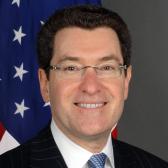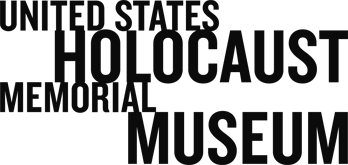NORMAN EISEN:
I sometimes feel as if my family’s history has, to some extent, mirrored the history of the past hundred years.
ALEISA FISHMAN:
Norman Eisen became known as the “ethics czar” through his work as Special Counsel for Ethics and Government Reform under President Obama. In 2011, Eisen was appointed as the U.S. Ambassador to the Czech Republic. And today he tells the story of the Ambassador’s residence in Prague, which echoes both Eisen’s personal family history and the arc of twentieth-century history.
Welcome to Voices on Antisemitism, a podcast series from the United States Holocaust Memorial Museum made possible by generous support from the Elizabeth and Oliver Stanton Foundation. I’m Aleisa Fishman. Every month, we invite a guest to reflect about the many ways that antisemitism and hatred influence our world today. From, his office at the Brookings Institution in Washington, D.C., here’s Norman Eisen.
NORMAN EISEN:
My mother, Frieda Eisen, immigrated here, after surviving the Holocaust in Europe. She was born in Czechoslovakia. And in 1944, along with many hundreds of thousands of others, she was deported, first to a ghetto and then to Auschwitz. Most of her family perished. She survived Auschwitz. She was transported to a slave labor camp, but she was fortunate and survived.
When I was appointed by President Obama to serve as Ambassador to the Czech Republic, I was thrilled. But I was also a little apprehensive. I had a mix of feelings. The United States Ambassador’s residence in Prague—the house where I lived—was originally built and owned by a well-known, perhaps the most well-known, Jewish family in then Czechoslovakia, the Petscheks. And I told my mother, “Not only am I going to be Ambassador, but the Ambassador lives … I’m going to be moving into the Petschek family compound.” My mom said, “Ooh! It’s like we’re taking Hyannis Port from the Kennedys.” So that excited her. She liked the thought that we would be living in this famous, famous Jewish property as temporary residents, courtesy of the United States. But I could never get my mom to come and visit.
Otto Petschek, the builder of the house, was from a prominent and wealthy Jewish family. The family had come to Prague as a result of fleeing a pogrom in the town of Kolin. Among other things, the house symbolizes that feeling of hope. It kind of captures all of the history of Europe.
Shortly after I arrived in the house, I was shown a beautiful antique table and underneath it a swastika that had been affixed there during WWII. And that was a shocking and startling moment for me. How remarkable to have the child of a Czech Holocaust survivor go back to live in a house, a Jewish-built house that was occupied by the Nazis. So that’s fundamentally amazing, but at the same time can be emotionally challenging.
Once I discovered that the table in our foyer had the Nazi sticker on it, I started looking for other traces of the Nazis. And I found those traces of the German occupation everywhere. So for example, I looked in a closet that had a stack of music books in it, and there at the bottom of a pile of music books was a Hitler Youth songbook, which was absolutely chilling to see—the young, hopeful faces on the cover of this songbook. But the tunes they were marching to were these hateful tunes of Nazi Germany. I didn’t only find German artifacts. I found traces of the whole remarkable history of the house. There was a lot of Otto Petschek’s stuff still in the house and incredibly his copy of the Tanakh, of the Jewish Bible; his Jewish encyclopedia; a rabbi’s chairs; the Sabbath candlesticks. All of those had survived. And then I found a crucifix and a hymnal. It turns out that during the Communist period, it was illegal to have Christian services. So the Ambassadors at those times organized Christian services in the house for people who otherwise, Czech people who otherwise, wouldn’t have been able to go, as well as for the diplomatic community. I used all that history as a way to explain the trajectory of the century to visitors. I liked to show them the swastika to remind them of how far we’ve come. But also as inspiration to all of us to do better. Because just as Otto Petschek could never have imagined that these occupiers would be in his house, we must take care to make sure that we’re never surprised that Europe goes off the rails again. So we have to work extra hard. I used it as an inspiration to others and to myself to work extra hard to keep Europe on that firm track of the values that inspired Mr. Petschek in building the house.
ALEISA FISHMAN:
Voices on Antisemitism is a podcast series of the United States Holocaust Memorial Museum. Join us every month to hear a new perspective on the continuing threat of antisemitism in our world today. We would appreciate your feedback on this series. Please visit our Web site, www.ushmm.org.

